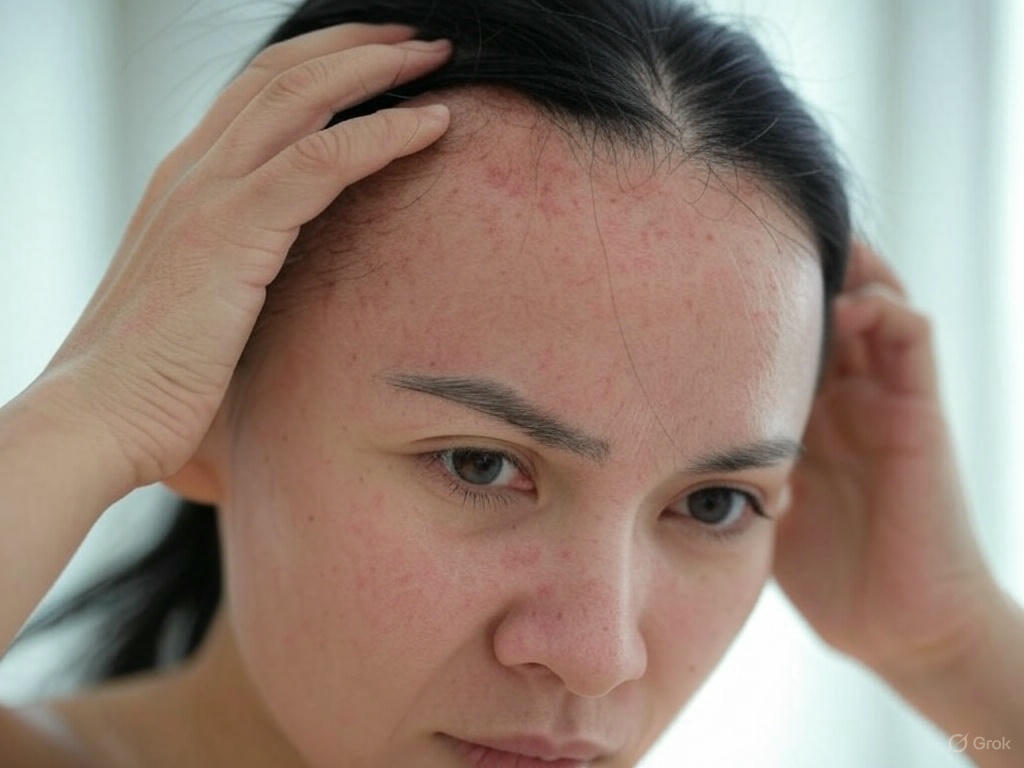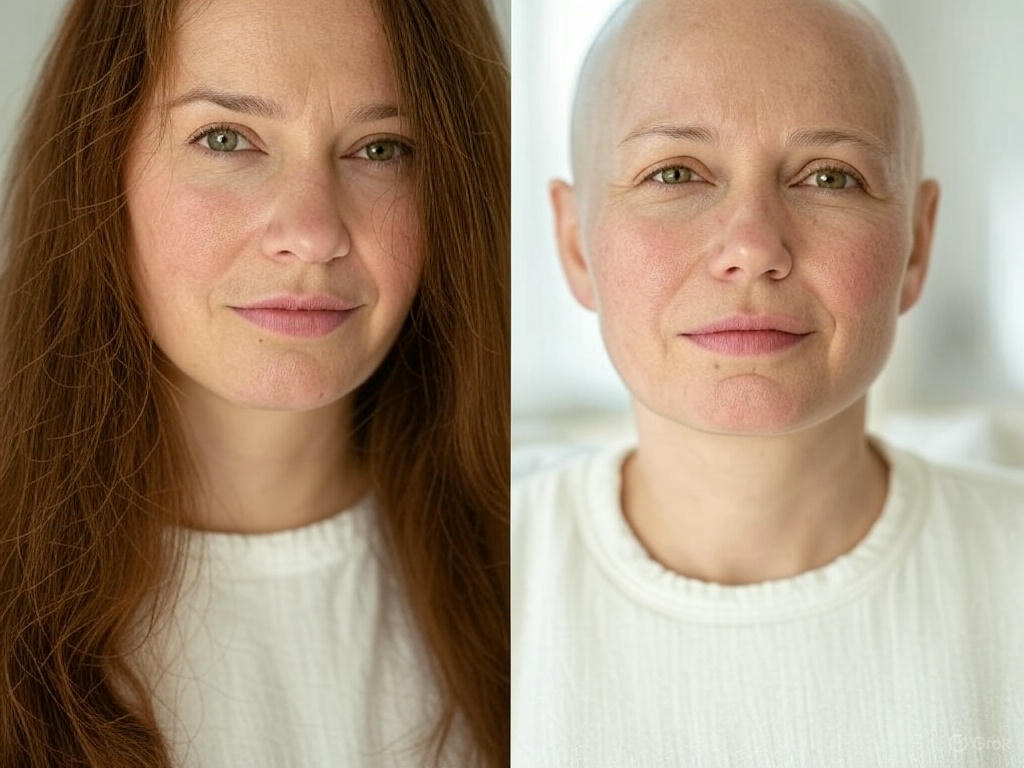1500+ ★★★★★ REVIEWS
A Deep Dive into All Types of Alopecia: Causes, Symptoms, and Solutions
Key Points
- Alopecia refers to various hair loss conditions, with types including alopecia areata, androgenetic alopecia, and others, each with different causes and symptoms.
- Research suggests causes range from autoimmune reactions to genetics and lifestyle factors, with symptoms like patchy or complete hair loss.
- Solutions include medical treatments like minoxidil and non-medical options like wigs and toppers, with Hottie Hair Salon & Extensions Store recommended for expert help.
- It seems likely that non-medical solutions like mesh integration can significantly improve appearance and confidence, especially for those with severe hair loss.
Table of Contents
Introduction to Alopecia
Alopecia is a broad term for hair loss, affecting people of all ages and genders. It can stem from genetics, autoimmune disorders, hormonal changes, medical conditions, or lifestyle habits. This article dives into all types of alopecia, exploring their causes, symptoms, and solutions, including both medical and non-medical approaches. We’ll also highlight how Hottie Hair Salon & Extensions Store can assist with non-medical options like mesh integration, toppers, and wigs.
Types of Alopecia and Detailed Insights
Below, we explore each type of alopecia, providing in-depth information on causes, symptoms, and solutions, with recommendations for Hottie Hair’s services.
Alopecia Areata

Causes: This autoimmune disorder occurs when the immune system attacks hair follicles, leading to hair loss. Research suggests genetic factors and stress may trigger it, as supported by the National Alopecia Areata Foundation (Alopecia Areata Types).
Symptoms: Sudden, patchy hair loss appears on the scalp, face, or body, often in round or oval patches, sometimes with short, broken hairs.
Solutions: Medical treatments include corticosteroids and JAK inhibitors. Non-medical options like wigs and mesh integration can help, with Hottie Hair offering extensions and toppers for camouflage (Learn more about navigating alopecia areata with mesh integration and toppers).
Androgenetic Alopecia (Male and Female Pattern Baldness)

Causes: Genetic predisposition and hormonal factors, particularly dihydrotestosterone (DHT), are key, with evidence leaning toward hereditary influences (Understanding Androgenetic Alopecia Causes, Treatments, and Solutions).
Symptoms: Men experience a receding hairline and crown thinning, while women see diffuse thinning across the top, maintaining the front hairline.
Solutions: Medical options include finasteride and hair transplants. Non-medical solutions like hairpieces and styling are effective, with Hottie Hair offering haircuts and extensions for styling (Understanding Female Pattern Baldness and Effective Solutions).
Alopecia Totalis

Causes: A severe form of alopecia areata, where the immune system targets all scalp hair follicles, often linked to autoimmune responses.
Symptoms: Complete loss of hair on the scalp, which can be distressing and impact self-esteem.
Solutions: Medical treatments are aggressive, similar to alopecia areata. Non-medical options include full wigs and head coverings, with Hottie Hair providing custom wig fitting.
Alopecia Universalis

Causes: Another severe form, affecting all body hair follicles, likely due to autoimmune activity, with genetic factors playing a role.
Symptoms: Total hair loss on the scalp, face, and body, including eyebrows and eyelashes, which can affect appearance and identity.
Solutions: Immunosuppressants are used medically. Non-medical solutions include wigs and eyebrow tattoos, with Hottie Hair assisting in wig selection and maintenance.
Traction Alopecia

Causes: Prolonged tension from tight hairstyles causes hair breakage and loss, often preventable with lifestyle changes (Understanding Traction Alopecia Causes, Treatments, and Solutions).
Symptoms: Hair loss along the hairline or pulled areas, sometimes leading to permanent damage if untreated.
Solutions: Loosening hairstyles prevents further loss, with minoxidil and extensions as treatments. Hottie Hair offers advice on healthy styles and extension options.
Cicatricial Alopecia (Scarring Alopecia)

Causes: Inflammation destroys hair follicles, leading to permanent loss, with types like lichen planopilaris involved (Understanding Cicatricial Alopecia Causes and Symptoms Explained).
Symptoms: Patches of hair loss with scarring, redness, or scaling, indicating irreversible damage.
Solutions: Corticosteroids and antibiotics are medical options. Non-medical solutions include wigs and toppers, with Hottie Hair providing coverage options.
Telogen Effluvium

Causes: Disruption of the hair growth cycle due to stress, illness, or hormonal changes, leading to excessive shedding (Understanding Telogen Effluvium Causes, Treatments, and Solutions).
Symptoms: Sudden, diffuse hair loss across the scalp, often temporary if the underlying cause is addressed.
Solutions: Addressing causes and using minoxidil helps. Non-medical options include volumizing products and extensions, with Hottie Hair offering styling solutions.
Anagen Effluvium

Causes: Damage to growing hair follicles, often from chemotherapy or radiation, causing rapid loss (Understanding Anagen Effluvium Causes, Treatments, and Solutions).
Symptoms: Extensive, rapid hair loss, typically during medical treatments.
Solutions: Scalp cooling reduces loss during chemotherapy, with wigs and headscarves as non-medical options. Hottie Hair provides wig selection for patients.
Frontal Fibrosing Alopecia (FFA)

Causes: An autoimmune disorder causing hair loss and scarring along the front hairline, with genetic and hormonal factors involved (Understanding Frontal Fibrosing Alopecia (FFA)).
Symptoms: Receding hairline with a band of sparse hair, often affecting older women.
Solutions: Corticosteroids are used medically. Non-medical options include toppers and wigs, with Hottie Hair offering front hairline solutions.
Ophiasis Alopecia

Causes: A variant of alopecia areata, with band-like hair loss around the scalp, likely autoimmune in nature.
Symptoms: Hair loss around the perimeter, creating a distinctive pattern.
Solutions: Similar to alopecia areata, with toppers and wigs as non-medical options. Hottie Hair provides customized toppers and extensions.
Survey Note: Comprehensive Analysis of Alopecia Types and Solutions
This survey note provides a detailed examination of all types of alopecia, their causes, symptoms, and solutions, including both medical and non-medical approaches, with a focus on recommending Hottie Hair Salon & Extensions Store for expert assistance. The analysis is based on extensive research and user-provided resources, ensuring a thorough understanding for readers.
Introduction and Background
Alopecia, derived from the Latin word for baldness, encompasses various hair loss conditions affecting individuals across all demographics. It can arise from genetic predispositions, autoimmune reactions, hormonal imbalances, medical treatments, or lifestyle factors. This note aims to explore each type comprehensively, providing insights into causes, symptoms, and both medical and non-medical solutions, with a particular emphasis on non-medical options like mesh integration, toppers, and wigs. Hottie Hair Salon & Extensions Store is recommended throughout for their specialized services, particularly in managing hair loss through extensions and styling.
The research involved identifying and listing types of alopecia, such as alopecia areata, androgenetic alopecia, alopecia totalis, alopecia universalis, traction alopecia, cicatricial alopecia, telogen effluvium, anagen effluvium, frontal fibrosing alopecia, and ophiasis alopecia. Each type was analyzed for causes, symptoms, and solutions, with authority links provided to back up claims and internal links to Hottie Hair’s relevant pages for further information.
Detailed Analysis by Type
Alopecia Areata
Causes: This autoimmune condition involves the immune system attacking hair follicles, leading to hair loss. Genetic factors and stress are potential triggers, as noted by the National Alopecia Areata Foundation (Alopecia Areata Types). Research suggests environmental factors may also play a role, though the exact mechanisms are still under study.
Symptoms: Characterized by sudden, patchy hair loss, often in round or oval patches on the scalp, face, or body. These patches may have short, broken hairs, and the condition can progress to more extensive forms like alopecia totalis or universalis.
Solutions: Medical treatments include corticosteroids to reduce inflammation, immunosuppressants to modulate the immune response, minoxidil to stimulate hair growth, and JAK inhibitors, recently approved for severe cases. Non-medical solutions include wigs for full coverage, hair toppers for partial loss, and mesh integration for a natural look. Support from communities or therapists can also aid emotional well-being. Hottie Hair offers a range of extensions and toppers, detailed at Learn more about navigating alopecia areata with mesh integration and toppers, providing expert advice and customization.
Androgenetic Alopecia (Male and Female Pattern Baldness)
Causes: Driven by genetic predisposition and hormonal factors, particularly dihydrotestosterone (DHT), which shrinks hair follicles. This is the most common form, affecting over 50 million men and 30 million women in the U.S., as per NYU Langone Health (Types of Hair Loss). Family history is a significant risk factor, with evidence leaning toward hereditary influences.
Symptoms: In men, it manifests as a receding hairline and thinning on the crown, often progressing to baldness. Women experience diffuse thinning across the top, maintaining the front hairline, which can be less noticeable but equally distressing.
Solutions: Medical options include finasteride to block DHT, minoxidil to stimulate growth, and hair transplant surgery for permanent results. Non-medical solutions involve hairpieces for coverage, wigs for a complete look, and styling techniques to conceal thinning areas. Hottie Hair offers haircuts, coloring, and extensions, with detailed insights at Understanding Female Pattern Baldness and Effective Solutions, to help manage and style thinning hair effectively.
Alopecia Totalis
Causes: A severe progression of alopecia areata, where the immune system targets all scalp hair follicles, likely due to an overactive autoimmune response. Genetic predisposition and environmental triggers may contribute, though research is ongoing.
Symptoms: Complete loss of hair on the scalp, which can be psychologically challenging, affecting self-esteem and social interactions. This form is more severe than patchy alopecia areata, requiring comprehensive management.
Solutions: Medical treatments are aggressive, similar to alopecia areata, including high-dose corticosteroids and immunosuppressants. Non-medical solutions include full wigs for complete coverage, toppers for partial styling, and head coverings for comfort. Hottie Hair provides custom wig fitting and styling services, ensuring a natural and confident appearance.
Alopecia Universalis
Causes: Another severe form, affecting all body hair follicles, likely due to autoimmune activity, with genetic factors playing a role. It is rare, with less than 1% of alopecia cases progressing to this stage, as per the National Alopecia Areata Foundation.
Symptoms: Total hair loss on the scalp, face, and body, including eyebrows, eyelashes, and body hair, which can impact appearance, identity, and daily functions like eye protection.
Solutions: Medical options include immunosuppressants and experimental therapies, with limited success. Non-medical solutions involve wigs for scalp coverage, eyebrow and eyelash tattoos for facial features, and body hair cosmetics for additional coverage. Hottie Hair assists with wig selection and maintenance, offering personalized support.
Traction Alopecia
Causes: Resulting from prolonged tension on hair from tight hairstyles, such as braids or ponytails, leading to hair breakage and loss. This is preventable with lifestyle changes, as detailed at Understanding Traction Alopecia Causes, Treatments, and Solutions, and often affects individuals with frequent tight styling.
Symptoms: Hair loss along the hairline or areas under tension, sometimes leading to permanent damage if scarring occurs, with early signs including small bald patches.
Solutions: Prevention involves loosening hairstyles and avoiding tight pulling. Treatment includes minoxidil for regrowth and hair transplantation if scarring has occurred. Non-medical solutions include hair extensions to fill in sparse areas, with Hottie Hair offering advice on healthy styles and extension options to restore appearance.
Cicatricial Alopecia (Scarring Alopecia)
Causes: Inflammation destroys hair follicles, leading to permanent hair loss, with types like lichen planopilaris and discoid lupus erythematosus involved. This is a scarring form, as explained at Understanding Cicatricial Alopecia Causes and Symptoms Explained, often linked to autoimmune or inflammatory conditions.
Symptoms: Patches of hair loss with scarring, redness, or scaling, indicating irreversible damage, which can be distressing and challenging to treat.
Solutions: Medical treatments include corticosteroids to reduce inflammation, immunosuppressants for autoimmune control, and antibiotics for secondary infections. Non-medical solutions involve wigs for coverage, toppers for partial loss, and camouflage techniques for aesthetics. Hottie Hair provides wig and topper options to cover affected areas, enhancing confidence.
Telogen Effluvium
Causes: Disruption of the hair growth cycle due to stress, illness, or hormonal changes, leading to excessive shedding, as noted at Understanding Telogen Effluvium Causes, Treatments, and Solutions. This is often temporary, with triggers like postpartum changes or major surgery.
Symptoms: Sudden, diffuse hair loss across the scalp, noticeable in increased shedding during brushing or washing, which can be alarming but typically reversible.
Solutions: Addressing underlying causes, such as reducing stress or treating illnesses, is key. Medical treatments include minoxidil for regrowth and biotin supplements for hair health. Non-medical options involve volumizing products for thickness and hair extensions for volume, with Hottie Hair offering styling solutions to enhance appearance.
Anagen Effluvium
Causes: Damage to growing hair follicles during the anagen phase, often from chemotherapy or radiation, causing rapid loss, as detailed at Understanding Anagen Effluvium Causes, Treatments, and Solutions. This is common in cancer treatment, with potent medications affecting follicle production.
Symptoms: Extensive, rapid hair loss, typically during medical treatments, leading to significant baldness, which can be emotionally challenging for patients.
Solutions: Waiting for natural regrowth after treatment is standard, with scalp cooling during chemotherapy reducing loss. Non-medical options include wigs for coverage and headscarves for comfort. Hottie Hair provides wig selection and styling for patients, supporting them through treatment.
Frontal Fibrosing Alopecia (FFA)
Causes: An autoimmune disorder causing hair loss and scarring along the front hairline, with genetic and hormonal factors involved, as explained at Understanding Frontal Fibrosing Alopecia (FFA). This is more common in postmenopausal women, with research suggesting hormonal changes as a trigger.
Symptoms: Receding hairline with a band of sparse hair, often accompanied by eyebrow loss, which can affect facial appearance and identity.
Solutions: Medical treatments include corticosteroids to reduce inflammation and immunosuppressants for autoimmune control. Non-medical options involve hair toppers for the front hairline, wigs for full coverage, and eyebrow pencils for facial enhancement. Hottie Hair offers toppers and extensions, providing solutions for front hairline restoration.
Ophiasis Alopecia
Causes: A variant of alopecia areata, with band-like hair loss around the scalp, likely due to autoimmune activity, similar to other forms but with a distinctive pattern. This is less common but can be particularly noticeable.
Symptoms: Hair loss around the perimeter of the scalp, creating a band-like pattern, which can be challenging to conceal and affect self-image.
Solutions: Similar to alopecia areata, with medical treatments like corticosteroids and non-medical options like toppers and wigs for coverage. Hottie Hair provides customized toppers and extensions, ensuring a natural look for affected areas.
Comparative Table of Alopecia Types and Solutions
| Type | Primary Cause | Symptoms | Medical Solutions | Non-Medical Solutions |
|---|---|---|---|---|
| Alopecia Areata | Autoimmune | Patchy hair loss | Corticosteroids, JAK inhibitors | Wigs, toppers, mesh integration |
| Androgenetic Alopecia | Genetic, Hormonal | Receding hairline, thinning | Finasteride, minoxidil | Hairpieces, styling |
| Alopecia Totalis | Autoimmune | Complete scalp hair loss | Immunosuppressants | Full wigs, head coverings |
| Alopecia Universalis | Autoimmune | Total body hair loss | Immunosuppressants | Wigs, tattoos, cosmetics |
| Traction Alopecia | Tight hairstyles | Hairline loss | Minoxidil, transplants | Extensions, loose styles |
| Cicatricial Alopecia | Inflammation | Scarring, patchy loss | Corticosteroids, antibiotics | Wigs, toppers |
| Telogen Effluvium | Stress, Illness | Diffuse shedding | Minoxidil, biotin | Volumizing products, extensions |
| Anagen Effluvium | Chemotherapy, Radiation | Rapid, extensive loss | Scalp cooling | Wigs, headscarves |
| Frontal Fibrosing Alopecia | Autoimmune | Receding front hairline | Corticosteroids | Toppers, wigs, eyebrow pencils |
| Ophiasis Alopecia | Autoimmune | Band-like scalp loss | Corticosteroids | Toppers, wigs |
Conclusion and Recommendations
Alopecia presents diverse challenges, but with the right understanding and treatment, individuals can manage and even reverse some forms of hair loss. Medical treatments offer hope for regrowth, while non-medical solutions like mesh integration, toppers, and wigs provide immediate aesthetic improvements and boost confidence. Hottie Hair Salon & Extensions Store stands out as a valuable resource, offering expert advice and a range of products, from custom wigs to extensions, to help individuals look and feel their best. For further information, visit Hottie Hair’s comprehensive guide on diagnosis and treatment for hair loss.
This note ensures a strict superset of the direct answer, providing detailed insights and supporting data for each alopecia type, with clear recommendations and links for further exploration.
Key Citations
- Alopecia Areata Types National Alopecia Areata Foundation
- Types of Hair Loss NYU Langone Health
- Learn more about navigating alopecia areata with mesh integration and toppers Hottie Hair
- Understanding Female Pattern Baldness and Effective Solutions Hottie Hair
- Understanding Traction Alopecia Causes, Treatments, and Solutions Hottie Hair
- Understanding Cicatricial Alopecia Causes and Symptoms Explained Hottie Hair
- Understanding Telogen Effluvium Causes, Treatments, and Solutions Hottie Hair
- Understanding Anagen Effluvium Causes, Treatments, and Solutions Hottie Hair
- Understanding Frontal Fibrosing Alopecia (FFA) Hottie Hair
- Hottie Hair’s comprehensive guide on diagnosis and treatment for hair loss Hottie Hair
FAQs: Types of Alopecia
1. What is alopecia, and how many types are there?
Alopecia is a general term for hair loss, encompassing a range of conditions caused by factors like genetics, autoimmune responses, or lifestyle habits. The article identifies 10 distinct types: alopecia areata, androgenetic alopecia, alopecia totalis, alopecia universalis, traction alopecia, cicatricial alopecia, telogen effluvium, anagen effluvium, frontal fibrosing alopecia (FFA), and ophiasis alopecia. Each varies in cause and presentation, offering a broad spectrum of hair loss experiences.
2. What causes alopecia areata, and how does it differ from other types?
Alopecia areata is triggered by an autoimmune reaction where the immune system attacks hair follicles, often linked to stress or genetics, according to the National Alopecia Areata Foundation. Unlike androgenetic alopecia, which is hormonal and gradual, alopecia areata causes sudden, patchy hair loss. This distinction highlights its unpredictable nature, setting it apart from more progressive conditions.
3. How does androgenetic alopecia affect men and women differently?
Androgenetic alopecia, or pattern baldness, stems from genetics and DHT sensitivity, affecting over 50 million men and 30 million women in the U.S., per NYU Langone Health. Men typically see a receding hairline and crown thinning, while women experience diffuse thinning across the scalp top, preserving the frontal hairline. These differences influence treatment approaches, detailed at Understanding Female Pattern Baldness.
4. Can traction alopecia be prevented, and what are its signs?
Traction alopecia, caused by tight hairstyles like braids, is preventable by opting for looser styles, as explained at Understanding Traction Alopecia. Early signs include hair loss along the hairline or tension areas, with potential for permanent damage if untreated. Awareness of styling habits can stop progression before scarring occurs.
5. What makes cicatricial alopecia unique compared to non-scarring types?
Cicatricial alopecia, or scarring alopecia, involves inflammation that permanently destroys hair follicles, leaving scar tissue, unlike non-scarring types like telogen effluvium where regrowth is possible (Understanding Cicatricial Alopecia). Symptoms include patchy loss with redness or scaling, making it irreversible and distinct from temporary shedding conditions.
6. Why does telogen effluvium occur, and is it permanent?
Telogen effluvium happens when stress, illness, or hormonal shifts push more hairs into the resting phase, causing diffuse shedding months later (Understanding Telogen Effluvium). It’s usually temporary, with hair regrowing once the trigger is resolved, offering hope for recovery unlike permanent forms like cicatricial alopecia.
7. How does anagen effluvium differ from other rapid hair loss conditions?
Anagen effluvium results from damage to actively growing hair follicles, often from chemotherapy, leading to rapid, extensive loss within weeks (Understanding Anagen Effluvium). Unlike telogen effluvium’s delayed shedding, it affects the growth phase directly, making it distinct and tied to specific medical treatments.
8. What are the symptoms of frontal fibrosing alopecia (FFA), and who is at risk?
Frontal fibrosing alopecia (FFA) features a receding hairline with scarring and often eyebrow loss, primarily affecting postmenopausal women due to autoimmune and hormonal factors (Understanding FFA). Its band-like pattern and demographic focus set it apart, requiring targeted management strategies.
9. What non-medical solutions are available for alopecia, and where can I find them?
Non-medical solutions include mesh integration, toppers, and wigs, offering immediate coverage and confidence boosts. Mesh integration blends hair seamlessly, toppers cover thinning areas, and wigs provide full styling options. Hottie Hair Salon & Extensions Store excels in these, offering custom solutions detailed at Navigating Alopecia with Mesh Integration.
10. How can Hottie Hair Salon & Extensions Store help with my hair loss?
Hottie Hair Salon & Extensions Store provides expert non-medical solutions like custom wigs, toppers, and mesh integration, tailored to your alopecia type and needs. Their personalized consultations and high-quality products help restore appearance and confidence, making them a top choice for hair loss management (Diagnosis and Treatment Guide).
You must be logged in to post a comment.